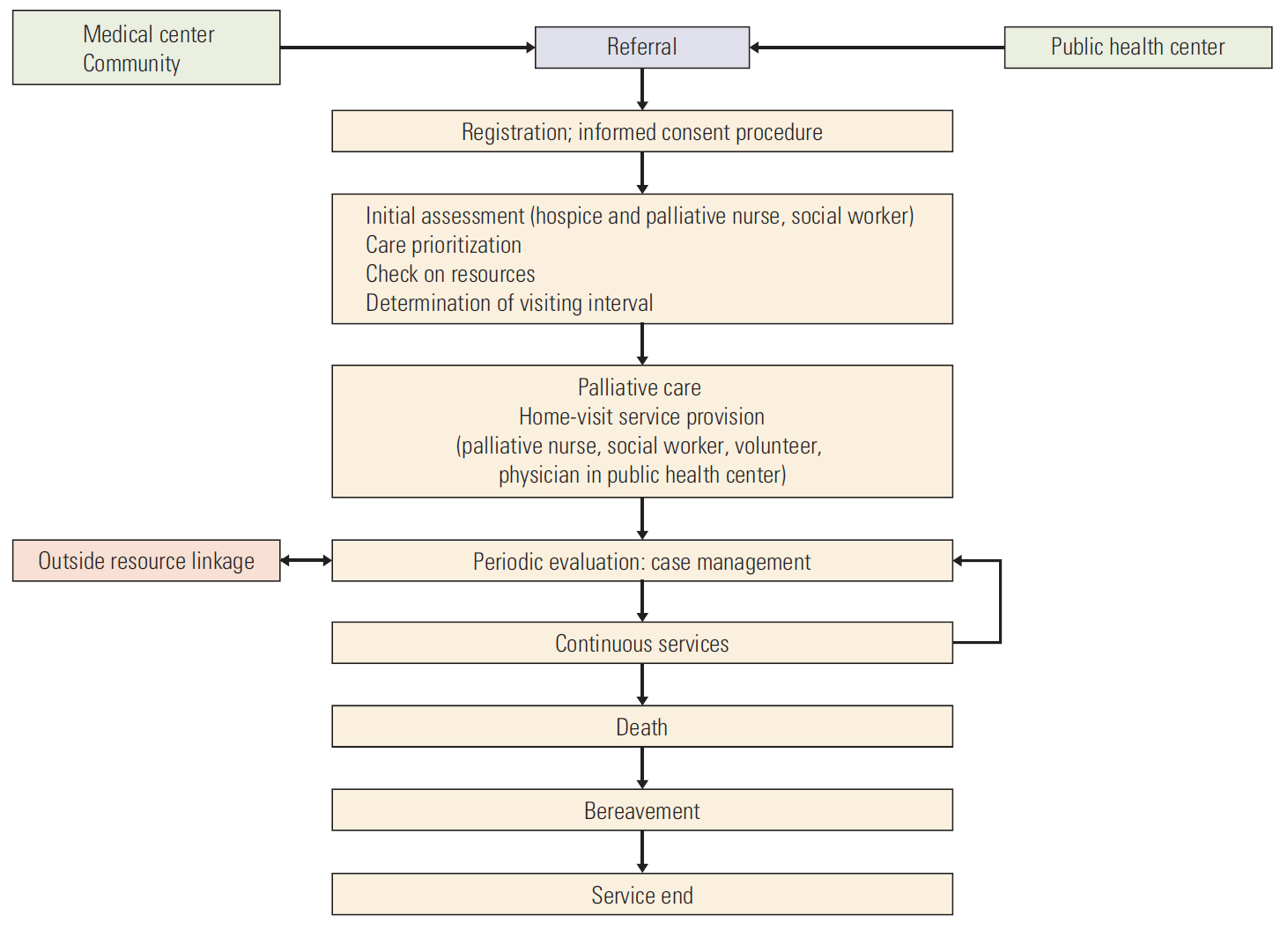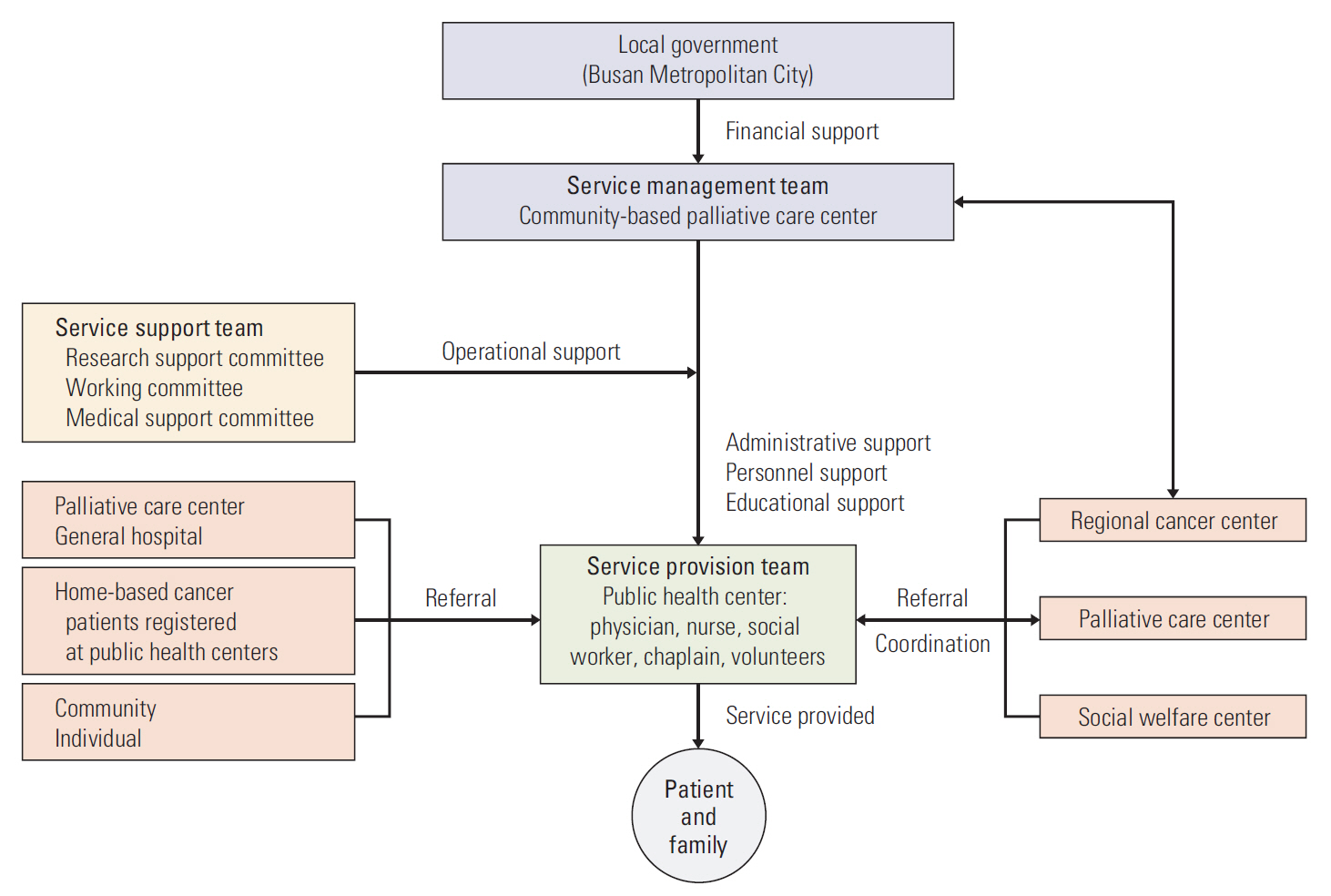Cancer Res Treat.
2017 Jul;49(3):559-568. 10.4143/crt.2016.276.
Development of a Community-Based Palliative Care Model for Advance Cancer Patients in Public Health Centers in Busan, Korea
- Affiliations
-
- 1Department of Nursing, Catholic University of Pusan, Busan, Korea. sochoi@cup.ac.kr
- 2Division of Hemato-Oncology, Department of Internal Medicine, Kosin University Gospel Hospital, Busan, Korea. ssh1533@hanmail.net
- 3Department of Aging and Social Work, Catholic University of Pusan, Busan, Korea.
- 4Industry Academic Cooperation Foundation, Catholic University of Pusan, Busan, Korea.
- KMID: 2388301
- DOI: http://doi.org/10.4143/crt.2016.276
Abstract
- PURPOSE
A feasible palliative care model for advance cancer patients is needed in Korea with its rapidly aging population and corresponding increase in cancer prevalence. This study describes the process involved in the development of a community-based palliative care (CBPC) model implemented originally in a Busan pilot project.
MATERIALS AND METHODS
The model development included steps I and II of the pilot project, identification of the service types, a survey exploring the community demand for palliative care, construction of an operational infrastructure, and the establishment of a service delivery system. Public health centers (including Busan regional cancer centers, palliative care centers, and social welfare centers) served as the regional hubs in the development of a palliative care model.
RESULTS
The palliative care project included the provision of palliative care, establishment of a support system for the operations, improvement of personnel capacity, development of an educational and promotional program, and the establishment of an assessment system to improve quality. The operational infrastructure included a service management team, provision teams, and a support team. The Busan Metropolitan City CBPC model was based on the principles of palliative care as well as the characteristics of public health centers that implemented the community health projects.
CONCLUSION
The potential use of the Busan CBPC model in Korea should be explored further through service evaluations.
Keyword
MeSH Terms
Figure
Reference
-
References
1. Ministry of Health and Welfare. Terminal cancer patient hospice utilization [Internet]. Sejong: Ministry of Health and Welfare;2015. [cited 2016 Jan 14]. Available from: http://www.mohw.go.kr/front_new/sch/index.jsp.2. Jung KW, Won YJ, Kong HJ, Oh CM, Cho H, Lee DH, et al. Cancer statistics in Korea: incidence, mortality, survival, and prevalence in 2012. Cancer Res Treat. 2015; 47:127–41.
Article3. Ministry of Health and Welfare. Establish a legal basis for hospice & palliative care and withdraw life-prolonging treatment [Internet]. Sejong: Ministry of Health and Welfare;2016. [cited 2016 Feb 10]. Available from: http://www.mohw.go.kr/front_new/al/sal0301vw.jsp?PAR_MENU_ID=04&MENU_ID=0403&page=1&CONT_SEQ=329848&SEARCHKEY=TITLE&SEARCHVALUE.4. Clark D, Wright M. The international observatory on end of life care: a global view of palliative care development. J Pain Symptom Manage. 2007; 33:542–6.
Article5. Gwyther L, Brennan F, Harding R. Advancing palliative care as a human right. J Pain Symptom Manage. 2009; 38:767–74.
Article6. Stjernsward J. Palliative care: the public health strategy. J Public Health Policy. 2007; 28:42–55.7. Institute for Research & Industry Cooperation; Catholic University of Pusan. Report of hospice and palliative care project. Busan: Publication Seri Yun;2014.8. Statistics Korea. Annual report on the cause of death statistics 2014 [Internet]. Daejeon: Statistics Korea;2016. [cited 2015 Dec 1]. Available from: http://kosis.kr/upsHtml/online/down-SrvcFile.do?PUBCODE=YD&FILE_NAME=/YD/06.xlsx&SEQ=104.9. NHS England. Population-based needs assessment: specialist palliative care [Internet]. Leeds: NHS England;2014. [cited 2016 Feb 10]. Available from: http://www.nescn.nhs.uk/wp-content/uploads/2015/02/Population-Needs-Assessment-Report-20143.pdf.10. Kim SN, Choi SO, Kim YJ, Lee SR. Development of community health center-based hospice management model: pilot project at a community health center in Busan. Korean J Hosp Palliat Care. 2010; 13:109–19.
Article11. Kang MH, Moon YS, Lee YJ, Kang YS, Kim HG, Lee GW, et al. Physical symptoms and psychiatric, social, spiritual and economical care needs of patients under home-based cancer service. Korean J Hosp Palliat Care. 2014; 17:216–22.
Article12. Ministry of Health; Welfare and Family Affairs. The management for home-based cancer patients. Seoul: Ministry of Health, Welfare and Family Affairs;2008.13. Stjernsward J, Foley KM, Ferris FD. The public health strategy for palliative care. J Pain Symptom Manage. 2007; 33:486–93.14. The Economist Intelligence Unit. The 2015 Quality of Death Index: ranking palliative care across the world [Internet]. Economic Insights;2015. [cited 2016 Jan 4]. Available from: http://www.economistinsights.com/healthcare/analysis/quality-death-index-2015.
- Full Text Links
- Actions
-
Cited
- CITED
-
- Close
- Share
- Similar articles
-
- Community-Based Oncology Nursing: Status and Prospects
- Development of Community Health Center-Based Hospice Management Model: Pilot Project at a Community Health Center in Busan
- Evaluation of Outcomes of the Busan Community-based Palliative Care Project in Korea
- Current Status of Home-Based Cancer Patients Management in Jeju
- Barriers to Effective Communication about Advance Care Planning and Palliative Care: A Qualitative Study





